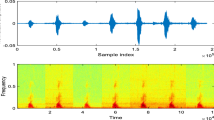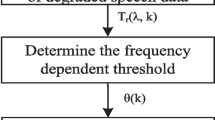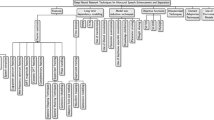Abstract
In this paper, a model order reduction approach is used with the aim to enhance the performance parameters of the speech signal. Initially, this model reduction technique is applied on the original higher order system for the reduction of the order of system while keeping all the features of the original one in it. The performance parameters such as SNR, NRMSE and SD for the reduced order system have been improved compared to the same performance parameters with original higher order one. Finally, the comparisons of these performance parameters are made to show to enhance the performance of reduced order system irrespective of the order and values of state space parameters.
Similar content being viewed by others
References
Adamou-Mitiche, A. B. H., & Mitiche, L. (2001). Comparative study of model reduction schemes- application to the digital filters synthesis. In International symposium on signal processing and its applications (ISSPA), Kuala Lumpur, Malaysia (pp. 675–678, 13–16).
Farhood, M., & Dullerud, G. E. (2007). Model reduction of nonstationary LPV systems. IEEE Transactions on Automatic Control, 52(2), 181–196.
Hao, J., Attias, H., Nagarajan, S., Lee, T.-W., & Sejnowski, T. J. (2009). Speech enhancement, gain, and noise spectrum adaptation using approximate Bayesian estimation. IEEE Transactions on Audio, Speech, and Language Processing, 17(1), 24–37.
Hung, J., Shen, J., & Lin-shan, L. (1998). Improved robustness for speech recognition using noisy conditions using correlated parallel model combination (pp. 553–556). New York: IEEE.
International Phonetic Association (1999). Handbook of the international phonetics association a guide to the use of IPA. Cambridge: Cambridge University Press.
Karam, J., & Saad, R. (2003). The effect of different compression schemes on speech signals. International Journal of Biological and Medical Sciences, 1(4), 230–234.
Laub, A. J., Heath, M. T., Paige, C. C., & Ward, R. C. (1987). Computation of system balancing transformations and other applications of simultaneous diagonalization algorithms. IEEE Transactions on Automatic Control, AC-32(2), 115–122.
Li, L., Xie, L., Li, G., & Soh, Y. C. (1999). A new technique to filter reduction for speech signal processing systems (pp. 1513–1516). New York: IEEE.
MATLAB. The Language of Technical Computing, 7.6.0.324 (R2008a). The MathWorks TM , signal processing toolbox, ss2tf.
Mehrmann, V., & Stykel, T. (2004). Balanced truncation model reduction for large-scale systems in descriptor form (Technical Report 157), pp. 1–32, DFG research center, Berlin.
Mitiche, L., & Adamou-Mitiche, A. B. H. (2004). A new approach for speech modeling based on model reduction (pp. 607–610). New York: IEEE
Mitiche, L., & Berkani, D. (2004). Speech modeling via model reduction. International Journal of Speech Technology, 311–318.
Mitiche, L., Derras, B., & Adamou-Mitiche, A. B. H. (2003a). Speech modeling by model-order reduction: SNR behavior. Electronics Letters, 39(17), 1288–1290.
Mitiche, L., Derras, B., & Mitiche-Adamou, A. B. H. (2003b). Speech modeling via model reduction (pp. 381–384). New York: IEEE.
Prasad, V., & Adamou-Mitiche, B. W. B. (2003). Nonlinear system identification and model reduction using artificial neural networks. Computers & Chemical Engineering, 27(2003), 1741–1754.
Proakis, J. G., & Manolakis, D. G. (2004). Digital signal processing (3rd edn.). Prentice Hall of India Private Limited.
Quinquis, A., Ioana, C., & Radoi, E. (2004). Polynomial phase signal modeling using warping-based order reduction (pp. II-741–II-744). New York: IEEE.
Reis, T., & Stykel, T. (2007). Balanced truncation model reduction of second-order systems (Technical Report), pp. 1–16, 376-2007, Berlin, Germany.
Sofonov, M. G., & Chiang, R. Y. (1989). A Schur method for balanced-truncation model reduction. IEEE Transactions on Automatic Control, 34(7), 729–733.
Wahlberg, B. (1990). ARMA spectral estimation of narrow-band processes via model reduction. IEEE Transactions on Acoustics, Speech, and Signal Processing, 38(7), 1144–1154.
Willcox, K., & Peraire, J. (2002). Balanced model reduction via the proper orthogonal decomposition. AIAA Journal, 40(11), 2323–2330.
Yang, W. (1999). Enhanced modified bark spectral distortion (EMBSD): an objective speech quality measure based on audible distortion and cognition model. Dissertation, Doctor of Philosophy, pp. 1–163.
Author information
Authors and Affiliations
Corresponding author
Rights and permissions
About this article
Cite this article
Arif, M., Anand, R.S. Enhancement of performance parameters of speech signal using model order reduction approach. Int J Speech Technol 14, 369–375 (2011). https://doi.org/10.1007/s10772-011-9117-1
Received:
Accepted:
Published:
Issue Date:
DOI: https://doi.org/10.1007/s10772-011-9117-1




